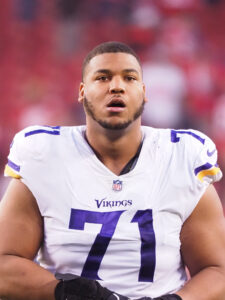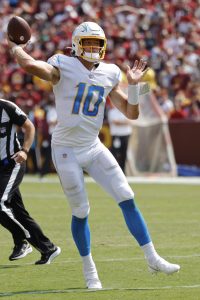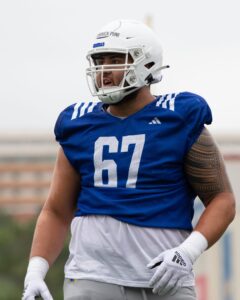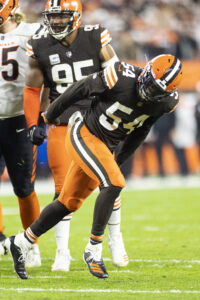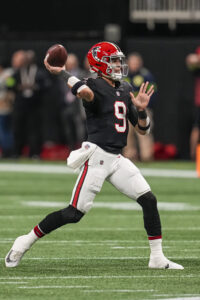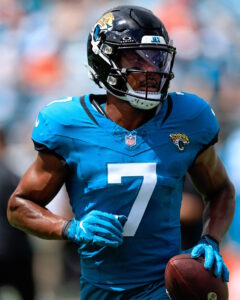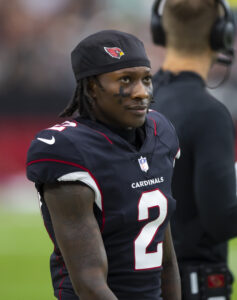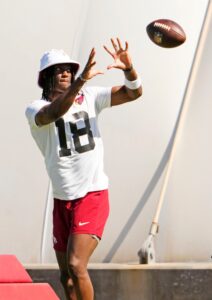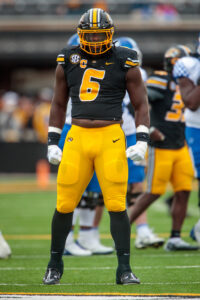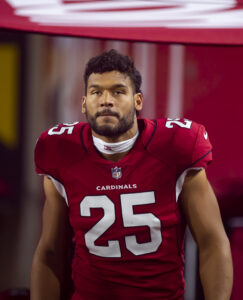Kwesi Adofo-Mensah had gone two seasons with the quarterback his predecessor signed, but after Kirk Cousins‘ fourth set of Vikings extension talks did not produce a deal in 2023, the current Minnesota GM finally cut the cord. Cousins’ departure headlined an eventful Vikings offseason, one that later included a market-setting wide receiver contract.
As the Vikings transition at quarterback, they will use some of the money freed up by Cousins’ departure — following a not insignificant dead money total stemming from void years — on one of their Rick Spielman-era acquisitions. While Minnesota’s offseason featured notable moves at several positions, the decisions made at quarterback and wideout defined it.
Extensions and restructures:
- Gave WR Justin Jefferson four-year, $140MM extension ($88.7MM guaranteed)
- Reworked S Harrison Smith‘s deal, settling on one-year, $9MM agreement ($7MM guaranteed)
Negotiations between the Vikings and Jefferson ran up to Week 1 last year. At that point, no team in the fifth-year option era (2011-present) had extended a first-round wide receiver with two years of rookie-deal control remaining. Jefferson and CeeDee Lamb were in that boat last year, and while extension rumors surfaced, no deals came to pass. The Vikings submitted an offer worth more than $28MM per year before the 2023 season started. With that proposal not topping Tyreek Hill‘s position-record AAV number, Jefferson predictably declined to set the stage for a 2024 reconvening. The superstar wideout was proven right by waiting.
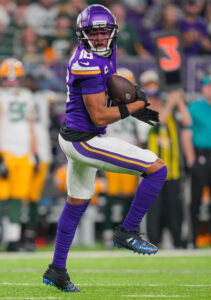 Even though Jefferson sustained a hamstring injury that sidelined him for seven games, he still managed a 1,000-yard season. Jefferson, 25, had already shattered Randy Moss‘ NFL record for receiving yardage through three seasons, accumulating 4,825. Jefferson’s age, his monster production, the Vikings moving off a proven QB’s contract and the receiver market shifting — following a record cap spike — beyond the $30MM place worked in the fifth-year pass catcher’s favor. Jefferson secured whopping terms and returned to work to begin establishing a rapport with Sam Darnold and J.J. McCarthy.
Even though Jefferson sustained a hamstring injury that sidelined him for seven games, he still managed a 1,000-yard season. Jefferson, 25, had already shattered Randy Moss‘ NFL record for receiving yardage through three seasons, accumulating 4,825. Jefferson’s age, his monster production, the Vikings moving off a proven QB’s contract and the receiver market shifting — following a record cap spike — beyond the $30MM place worked in the fifth-year pass catcher’s favor. Jefferson secured whopping terms and returned to work to begin establishing a rapport with Sam Darnold and J.J. McCarthy.
Skipping the start of Vikings OTAs in an effort to become the NFL’s highest-paid non-quarterback, Jefferson succeeded by passing Nick Bosa‘s $34MM-per-year contract. Also possessing leverage stemming from the Vikings’ natural interest in having their top player at workouts to begin training alongside its new QBs, the LSU alum pounced. Jefferson secured record-smashing guarantee figures, prevented the Vikings from backloading his deal the way Hill and Davante Adams‘ contracts are structured and managed this on a four-year agreement — one shorter than the Vikes initially sought.
The fifth wide receiver chosen in a memorable 2020 first round, Jefferson has set guarantee bars that are complicating the Cowboys and 49ers’ negotiations with their 2020 first-round wideouts. His total guarantees ($110MM) checked in $26MM north of A.J. Brown‘s new mark at the position. More importantly, the full guarantees ($88.7MM) are $36MM higher than the next-closest wideout. The WR investment business is booming, and the guarantees the Vikings authorized may give teams pause.
Rumblings about teams considering two-first-rounder trade offers for Jefferson emerged, with the Vikings loosely linked to a trade-up for LSU’s Malik Nabers. Little in terms of concrete info — unlike the Vikes and Giants’ Drake Maye trade-up offers — came out, however. No wide receiver has fetched two first-round picks in a trade since the 2000 offseason saw it happen twice — for Joey Galloway (Seahawks to Cowboys) and Keyshawn Johnson (Jets to Buccaneers) — but after Hill and Adams fetched first- and second-round picks in 2022 swaps, Jefferson’s age and the exploding WR market would have made him a clear candidate to end this drought.
The Vikings have a history of extending receivers and then trading them, having taken this route with Moss (2005) and Stefon Diggs (2020). Minnesota also unloaded Percy Harvin (2013) rather than extend him, but the Adofo-Mensah regime finished the Jefferson process with a commitment.
 As it stands, the Vikings will pair Jefferson’s megadeal with McCarthy and Jordan Addison‘s rookie contracts. Although Minnesota now has the NFL’s highest-paid wide receiver and tight end (T.J. Hockenson), getting off Cousins’ contract will help the club afford the market-setting accords.
As it stands, the Vikings will pair Jefferson’s megadeal with McCarthy and Jordan Addison‘s rookie contracts. Although Minnesota now has the NFL’s highest-paid wide receiver and tight end (T.J. Hockenson), getting off Cousins’ contract will help the club afford the market-setting accords.
For a second straight year, the Vikings gave Smith a pay cut. The safety market’s inconsistency over the past two offseasons has impacted accomplished veterans. Smith signed two extensions that placed him atop the position’s market — in 2016 and 2021 — but Adofo-Mensah has led the way in back-to-back contract reworkings.
Smith, 35, is the Vikings’ longest-tenured player by a wide margin. He had agreed to a four-year, $64MM extension in August 2021, but after a 2022 restructure, the veteran Pro Bowler agreed to a $7MM pay cut in 2023 and again reduced his deal in March. Smith’s 2021 extension ran through 2025; it now expires a year early, via void years which have become a thorny subject during the Adofo-Mensah regime. Smith reduced a $15.3MM base salary to $9MM, with a $7MM signing bonus representing a solid guarantee for a 13th-year veteran at an unstable position.
Pro Football Focus ranked Smith, whose 176 career games are tied for fifth among defenders in Vikings history, 34th among safeties last season. If Smith is not re-signed before the 2025 league year, the Vikings will be tagged with $9.5MM in dead money. This would remind of Dalvin Tomlinson‘s 2023 exit.
Free agency additions:
- Jonathan Greenard, OLB. Four years, $76MM ($38MM guaranteed)
- Andrew Van Ginkel, LB. Two years, $20MM ($10MM guaranteed)
- Blake Cashman, ILB. Three years, $22.5MM ($9.48MM guaranteed)
- Sam Darnold, QB. One year, $10MM ($8.75MM guaranteed)
- Aaron Jones, RB. One year, $7MM ($7MM guaranteed)
- Shaquill Griffin, CB. One year, $4.55MM ($3.99MM guaranteed)
- Jerry Tillery, DL. One year, $2.75MM ($1.47MM guaranteed)
- Dan Feeney, OL. One year, $1.8MM ($1.38MM guaranteed)
- Trent Sherfield, WR. One year, $1.79MM ($1MM guaranteed)
- Jihad Ward, DL. One year, $1.79MM ($1MM guaranteed)
- Jonah Williams, DL. One year, $1.5MM ($350K guaranteed)
- Robert Tonyan, TE. One year, $1.13MM ($150K guaranteed)
- Kamu Grugier-Hill, LB. One year, $1.38MM ($143K guaranteed)
Not traded for one another, Greenard and Danielle Hunter — PFR’s Nos. 5 and 6 free agents this year — will nevertheless move into each other’s 2023 roles. The Vikings added Greenard early in free agency, doing so before Hunter committed to the Texans. Minnesota showed interest in Bryce Huff but paid more for Greenard. The new Vikings edge rusher’s age (27) works in his favor; he is three years younger than Hunter. The latter has delivered better work, but the Vikings are betting on Greenard’s best NFL stretch being ahead.
 Drafted in Round 3 before Nick Caserio took over as GM, Greenard excelled under both Lovie Smith and then DeMeco Ryans. Greenard had tallied an eight-sack season (in 2021) before an injury-plagued 2022 stalled his early-career momentum. Last season brought new production territory. Ranking 20th with 33 quarterback pressures, Greenard led the Texans in sacks (12.5) despite Will Anderson Jr. winning Defensive Rookie of the Year acclaim and smashed his career-high with 22 QB hits. Greenard ranked sixth among edge rushers in ESPN’s pass rush win rate metric in 2023.
Drafted in Round 3 before Nick Caserio took over as GM, Greenard excelled under both Lovie Smith and then DeMeco Ryans. Greenard had tallied an eight-sack season (in 2021) before an injury-plagued 2022 stalled his early-career momentum. Last season brought new production territory. Ranking 20th with 33 quarterback pressures, Greenard led the Texans in sacks (12.5) despite Will Anderson Jr. winning Defensive Rookie of the Year acclaim and smashed his career-high with 22 QB hits. Greenard ranked sixth among edge rushers in ESPN’s pass rush win rate metric in 2023.
Starting over at OLB, the Vikings need this pace to continue. They still managed to land a 27-year-old edge defender at an upper-mid-market rate. Greenard’s $19MM AAV ranks 15th among edges, though his $38MM guarantee at signing sits eighth. He could certainly reward the Vikings on this deal, especially as the pass rush market — likely via Micah Parsons and a third Myles Garrett contract — moves toward $40MM per year.
A year after moving off the Dalvin Cook contract, the Vikings made a short-term bet on another 2017 RB draftee. Jones does not have the rushing numbers Cook compiled in Minneapolis, but the seven-year Packer is a slightly better receiving option who certainly showed more gas in the tank last season. The Vikings are quite familiar with the versatile back, who closed last season with five straight 100-yard rushing games to propel the Pack to the divisional round, and their interest emerged soon after Green Bay cut bait.
The Packers added a younger back (Josh Jacobs) but one that has not shown what Jones has as an outlet option. After reducing Jones’ pay in 2023, the Packers aimed to cut his wages once again. The sides could not agree on common ground, and the team dropped Jones shortly after the Jacobs deal was finalized. Jones’ Vikings guarantee surpasses Alexander Mattison‘s 2023 number, though not by too much, as the Vikes have one of this era’s best RBs at a midlevel rate.
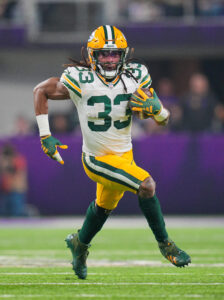 The team will bet on the aging (by RB standards) talent having juice left. The 1-A back in timeshares with Jamaal Williams and AJ Dillon in his career, Jones has logged 1,449 career touches. That ranks ninth among active RBs, though the number is close to where Cook’s count stood (1,503) when the Vikings dropped him.
The team will bet on the aging (by RB standards) talent having juice left. The 1-A back in timeshares with Jamaal Williams and AJ Dillon in his career, Jones has logged 1,449 career touches. That ranks ninth among active RBs, though the number is close to where Cook’s count stood (1,503) when the Vikings dropped him.
Jones rounds out an impressive skill-position cadre that includes Jefferson, Addison and Hockenson. This array of weaponry will be available to McCarthy in the long term, but it also could represent (by far) the best options Darnold has worked with as a pro. Brock Purdy enjoyed the 49ers’ unmatched arsenal during Darnold’s San Francisco year; his Jets and Panthers arrays, with Christian McCaffrey largely injured, do not rival what the Vikings possess. Although Darnold has been given plenty of time (56 starts) to show he is a mediocre quarterback, the former No. 3 overall pick chose an interesting opportunity in Minnesota.
Also tied to the Broncos and Commanders, Darnold chose the Vikings. Denver did not make a firm offer, and it is unknown where Washington went. Regardless, Darnold is poised to enter training camp as Minnesota’s starter. Darnold has flashed at points, but for the most part, the USC alum has struggled as a pro. The 27-year-old QB has never ranked higher than 25th in QBR, but he did not have enough snaps to qualify during an intriguing 2022 season in which he helped lead the Panthers back into the playoff race. Granted, this was due to a terrible NFC South, but Darnold averaged 8.2 yards per attempt with a limited Carolina skill corps that season.
It would not surprise to see the Vikings slow-play McCarthy’s climb; this would give Darnold a window to show better form and create a potential starter market for himself in 2025.
 In addition to rebooting on the edge, the Vikes spent midlevel cash to add linebacking help. Van Ginkel can be classified as a hybrid player, having experience on the edge and off the ball. He helped the Dolphins as a rotational rusher and emergency OLB starter last season, compiling six sacks and 19 QB hits.
In addition to rebooting on the edge, the Vikes spent midlevel cash to add linebacking help. Van Ginkel can be classified as a hybrid player, having experience on the edge and off the ball. He helped the Dolphins as a rotational rusher and emergency OLB starter last season, compiling six sacks and 19 QB hits.
The Dolphins drafted Van Ginkel during Brian Flores‘ time in Miami, and he reached 20 QB hits in the current Vikings DC’s South Florida finale (2021). This made the Vikings’ interest unsurprising, and the team’s Cashman move points Van Ginkel to the edge. A rumored Flores-Christian Wilkins reunion did not happen, but the Vikes did not leave free agency without adding one of their DC’s ex-charges.
Cashman will join emerging UDFA Ivan Pace in the Twin Cities, and this payday marks the culmination of a journey that had the ex-Jet as a special-teamer not long ago. Strictly a special-teamer from 2020-21, Cashman still only played 14% of the Texans’ defensive snaps in 2022. But Ryans gave him steady work last year, using him at a 71% snap rate. Cashman notched 106 tackles to eclipse his career-best number by a cool 66, adding nine tackles for loss en route to PFF ranking him as a top-10 ILB regular. The Vikings are giving the Minnesota alum a chance to come home as well, as Cashman grew up in nearby Eden Prairie.
Mentioned as one of the many suitors for franchise-tagged Chiefs cornerback L’Jarius Sneed, the Vikings only exited free agency with Griffin. While Griffin has 79 starts on his resume, two teams — the Jaguars and Texans — cut the soon-to-be 29-year-old CB in 2023. PFF still rated Griffin as a top-50 corner last season, but the former Seahawks mainstay qualifies as more stopgap than difference-maker. As it stands, Griffin has a path to a starting role. The Vikings, as should be expected, are still being tied to seeking CB help.
Re-signings:
- Blake Brandel, G. Three years, $9.5MM ($3.1MM guaranteed)
- David Quessenberry, T. One year, $1.8MM ($1.38MM guaranteed)
- Dalton Risner, G. One year, $2.41MM ($1.1MM guaranteed)
- Jonathan Bullard, DL. One year, $2.25MM ($750K guaranteed)
- Johnny Mundt, TE. One year, $2MM ($750K guaranteed)
- Brandon Powell, WR. One year, $2MM ($625K guaranteed)
 Even as the guard market produced five eight-figure-per-year UFA agreements this offseason, Risner is having a tough time convincing teams he is near that level. A Broncos starter for four seasons, the former second-round pick had not exactly received poor marks from the advanced metrics providers. But Risner has now struck out twice in free agency, waiting into the 2023 season before landing a gig and sitting on this year’s open market until May. Now heading into his age-29 season, the veteran guard is running out of time to cash in. He is sitting on 73 career starts, 11 coming with the Vikings last year.
Even as the guard market produced five eight-figure-per-year UFA agreements this offseason, Risner is having a tough time convincing teams he is near that level. A Broncos starter for four seasons, the former second-round pick had not exactly received poor marks from the advanced metrics providers. But Risner has now struck out twice in free agency, waiting into the 2023 season before landing a gig and sitting on this year’s open market until May. Now heading into his age-29 season, the veteran guard is running out of time to cash in. He is sitting on 73 career starts, 11 coming with the Vikings last year.
Risner made his way into Minnesota’s starting lineup in October 2023, eventually replacing the traded Ezra Cleveland. PFF assigned Risner a mid-pack rating (46th), though ESPN’s pass block win rate metric slotted him ninth among all interior linemen. He will battle Brandel for the Vikes’ left guard gig. Despite having just five starts and just 503 offensive snaps on his NFL resume, Brandel commanded more money than Risner this offseason.
Notable losses:
- Cam Akers, RB
- Anthony Barr, LB
- Kirk Cousins, QB
- Marcus Davenport, OLB
- Josh Dobbs, QB
- Troy Dye, LB
- Jordan Hicks, ILB
- Danielle Hunter, OLB
- Greg Joseph, K
- Dean Lowry, DL (released)
- James Lynch, DL
- Alexander Mattison, RB (released)
- K.J. Osborn, WR
- Chris Reed, G
- Austin Schlottmann, OL
- Khyiris Tonga, DL
- Oli Udoh, OL
- Nick Vigil, ILB
- D.J. Wonnum, OLB
The contracts Cousins and Hunter played out made the Vikings a historical outlier regarding an ability to retain top talent. Minnesota could not use its franchise tag on Hunter due to the parties’ August 2023 reworking, and Washington having tagged Cousins twice made a third tag — which no team has applied since the 2006 CBA made doing so prohibitive — a non-starter. This led to a nine-year Vikings sack ace and the team’s six-year quarterback heading south.





